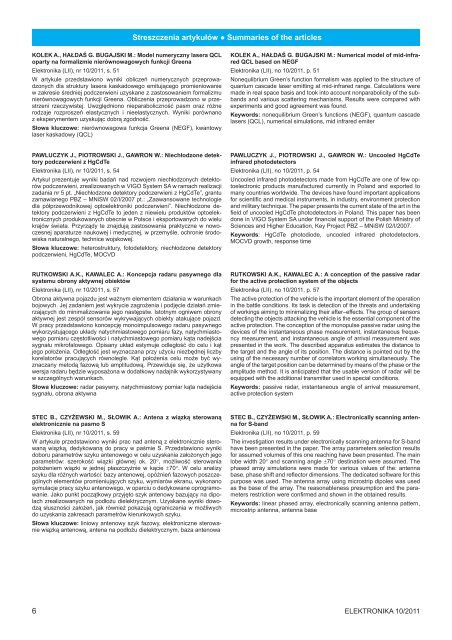Elektronika 2011-10 I.pdf - Instytut Systemów Elektronicznych ...
Elektronika 2011-10 I.pdf - Instytut Systemów Elektronicznych ...
Elektronika 2011-10 I.pdf - Instytut Systemów Elektronicznych ...
- No tags were found...
Create successful ePaper yourself
Turn your PDF publications into a flip-book with our unique Google optimized e-Paper software.
Streszczenia artykułów ● Summaries of the articlesKOLEK A., HAŁDAŚ G. BUGAJSKI M.: Model numeryczny lasera QCLoparty na formalizmie nierównowagowych funkcji Greena<strong>Elektronika</strong> (LII), nr <strong>10</strong>/<strong>2011</strong>, s. 51W artykule przedstawiono wyniki obliczeń numerycznych przeprowadzonychdla struktury lasera kaskadowego emitującego promieniowaniew zakresie średniej podczerwieni uzyskane z zastosowaniem formalizmunierównowagowych funkcji Greena. Obliczenia przeprowadzono w przestrzenirzeczywistej. Uwzględniono nieparaboliczność pasm oraz różnerodzaje rozproszeń elastycznych i nieelastycznych. Wyniki porównanoz eksperymentem uzyskując dobrą zgodność.Słowa kluczowe: nierównowagowa funkcja Greena (NEGF), kwantowylaser kaskadowy (QCL)KOLEK A., HAŁDAŚ G. BUGAJSKI M.: Numerical model of mid-infraredQCL based on NEGF<strong>Elektronika</strong> (LII), no <strong>10</strong>/<strong>2011</strong>, p. 51Nonequlibrium Green’s function formalism was applied to the structure ofquantum cascade laser emitting at mid-infrared range. Calculations weremade in real space basis and took into account nonparabolicity of the subbandsand various scattering mechanisms. Results were compared withexperiments and good agreement was found.Keywords: nonequilibrium Green’s functions (NEGF), quantum cascadelasers (QCL), numerical simulations, mid infrared emiterPAWLUCZYK J., PIOTROWSKI J., GAWRON W.: Niechłodzone detektorypodczerwieni z HgCdTe<strong>Elektronika</strong> (LII), nr <strong>10</strong>/<strong>2011</strong>, s. 54Artykuł prezentuje wyniki badań nad rozwojem niechłodzonych detektorówpodczerwieni, zrealizowanych w VIGO System SA w ramach realizacjizadania nr 5 pt. „Niechłodzone detektory podczerwieni z HgCdTe”, grantuzamawianego PBZ – MNiSW 02/I/2007 pt.: „Zaawansowane technologiedla półprzewodnikowej optoelektroniki podczerwieni”. Niechłodzone detektorypodczerwieni z HgCdTe to jeden z niewielu produktów optoelektronicznychprodukowanych obecnie w Polsce i eksportowanych do wielukrajów świata. Przyrządy te znajdują zastosowania praktyczne w nowoczesnejaparaturze naukowej i medycznej, w przemyśle, ochronie środowiskanaturalnego, technice wojskowej.Słowa kluczowe: heterostruktury, fotodetektory, niechłodzone detektorypodczerwieni, HgCdTe, MOCVDPAWLUCZYK J., PIOTROWSKI J., GAWRON W.: Uncooled HgCdTeinfrared photodetectors<strong>Elektronika</strong> (LII), no <strong>10</strong>/<strong>2011</strong>, p. 54Uncooled infrared photodetectors made from HgCdTe are one of few optoelectronicproducts manufactured currently in Poland and exported tomany countries worldwide. The devices have found important applicationsfor scientific and medical instruments, in industry, environment protectionand military technique. The paper presents the current state of the art in thefield of uncooled HgCdTe photodetectors in Poland. This paper has beendone in VIGO System SA under financial support of the Polish Ministry ofSciences and Higher Education, Key Project PBZ – MNiSW 02/I/2007.Keywords: HgCdTe photodiode, uncooled infrared photodetectors,MOCVD growth, response timeRUTKOWSKI A.K., KAWALEC A.: Koncepcja radaru pasywnego dlasystemu obrony aktywnej obiektów<strong>Elektronika</strong> (LII), nr <strong>10</strong>/<strong>2011</strong>, s. 57Obrona aktywna pojazdu jest ważnym elementem działania w warunkachbojowych. Jej zadaniem jest wykrycie zagrożenia i podjęcie działań zmierzającychdo minimalizowania jego następstw. Istotnym ogniwem obronyaktywnej jest zespół sensorów wykrywających obiekty atakujące pojazd.W pracy przedstawiono koncepcję monoimpulsowego radaru pasywnegowykorzystującego układy natychmiastowego pomiaru fazy, natychmiastowegopomiaru częstotliwości i natychmiastowego pomiaru kąta nadejściasygnału mikrofalowego. Opisany układ estymuje odległość do celu i kątjego położenia. Odległość jest wyznaczana przy użyciu niezbędnej liczbykorelatorów pracujących równolegle. Kąt położenia celu może być wyznaczanymetodą fazową lub amplitudową. Przewiduje się, że użytkowawersja radaru będzie wyposażona w dodatkowy nadajnik wykorzystywanyw szczególnych warunkach.Słowa kluczowe: radar pasywny, natychmiastowy pomiar kąta nadejściasygnału, obrona aktywnaRUTKOWSKI A.K., KAWALEC A.: A conception of the passive radarfor the active protection system of the objects<strong>Elektronika</strong> (LII), no <strong>10</strong>/<strong>2011</strong>, p. 57The active protection of the vehicle is the important element of the operationin the battle conditions. Its task is detection of the threats and undertakingof workings aiming to minimalizing their after–effects. The group of sensorsdetecting the objects attacking the vehicle is the essential component of theactive protection. The conception of the monopulse passive radar using thedevices of the instantaneous phase measurement, instantaneous frequencymeasurement, and instantaneous angle of arrival measurement waspresented in the work. The described apparatus estimates the distance tothe target and the angle of its position. The distance is pointed out by theusing of the necessary number of correlators working simultaneously. Theangle of the target position can be determined by means of the phase or theamplitude method. It is anticipated that the usable version of radar will beequipped with the additional transmitter used in special conditions.Keywords: passive radar, instantaneous angle of arrival measurement,active protection systemSTEC B., CZYŻEWSKI M., SŁOWIK A.: Antena z wiązką sterowanąelektronicznie na pasmo S<strong>Elektronika</strong> (LII), nr <strong>10</strong>/<strong>2011</strong>, s. 59W artykule przedstawiono wyniki prac nad anteną z elektronicznie sterowanąwiązką, dedykowaną do pracy w paśmie S. Przedstawiono wynikidoboru parametrów szyku antenowego w celu uzyskania założonych jegoparametrów: szerokość wiązki głównej ok. 20°, możliwość sterowaniapołożeniem wiązki w jednej płaszczyźnie w kącie ±70°. W celu analizyszyku dla różnych wartości: bazy antenowej, opóźnień fazowych poszczególnychelementów promieniujących szyku, wymiarów ekranu, wykonanosymulacje pracy szyku antenowego, w oparciu o dedykowane oprogramowanie.Jako punkt początkowy przyjęto szyk antenowy bazujący na dipolachzrealizowanych na podłożu dielektrycznym. Uzyskane wyniki dowodząsłuszności założeń, jak również pokazują ograniczenia w możliwychdo uzyskania zakresach parametrów kierunkowych szyku.Słowa kluczowe: liniowy antenowy szyk fazowy, elektroniczne sterowaniewiązką antenową, antena na podłożu dielektrycznym, baza antenowaSTEC B., CZYŻEWSKI M., SŁOWIK A.: Electronically scanning antennafor S-band<strong>Elektronika</strong> (LII), no <strong>10</strong>/<strong>2011</strong>, p. 59The investigation results under electronically scanning antenna for S-bandhave been presented in the paper. The array parameters selection resultsfor assumed volumes of this one reaching have been presented. The mainlobe width 20° and scanning angle ±70° destination were assumed. Thephased array simulations were made for various values of the: antennabase, phase shift and reflector dimensions. The dedicated software for thispurpose was used. The antenna array using microstrip dipoles was usedas the base of the array. The reasonableness presumption and the parametersrestriction were confirmed and shown in the obtained results.Keywords: linear phased array, electronically scanning antenna pattern,microstrip antenna, antenna base<strong>Elektronika</strong> <strong>10</strong>/<strong>2011</strong>
















